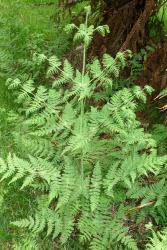- ≡ Pteris sect. Histiopteris J.Agardh, Recens. Spec. Pter. 76 (1839)
Terrestrial ferns. Rhizomes long-creeping, bearing hairs and clathrate scales. Fronds monomorphic. Stipes glabrous. Laminae 2–3-pinnate, herbaceous, glabrous and usually glaucous when young; primary pinnae sessile, sometimes with reduced stipule-like basal pinnules (not NZ). Veins reticulate, areoles without included veinlets; a marginal connecting vein also present. Sori more or less continuous around the lamina margin, borne on the connecting vein, superficial; paraphyses present. Pseudoindusium (formed from the reflexed membranous lamina margin) opening inwards; true inner indusium absent. Spores monolete, coarsely tuberculate.
On morphological grounds, Histiopteris appears anomalous within Dennstaedtiaceae, lacking the hairs typical of the family, and having scales on the rhizome, although Kramer (1990) referred to these as pluriseriate bristles rather than true scales. The reported chromosome numbers of n = 48 and 96 do not relate easily to other members of the family. However, molecular evidence indicates that Histiopteris is clearly embedded within Dennstaedtiaceae (Perrie et al. 2015). Holttum (1967) showed that Lepidocaulon is congeneric with Histiopteris and listed about six species in his expanded genus.
Histiopteris can be recognised by its long-creeping rhizomes, glabrous fronds, presence of scales on the rhizome and stipe bases, sessile primary pinnae, reticulate venation, and sori more or less continuous around the ultimate lamina segments and protected by the inrolled lamina margins.
A genus of one pantropical species that extends into temperate areas of southern Chile, South Africa, Australia, New Zealand and the subantarctic islands (Brownsey 1998), and five or six other species in Malesia, Fiji, Vanuatu and the Solomon Islands (Holttum 1967). One non-endemic species in New Zealand.
| Category | Number |
|---|---|
| Indigenous (Non-endemic) | 1 |
| Total | 1 |
Chromosome counts of n = 48 and n = 96 have been reported in Histiopteris (Löve et al. 1977), but the base number is not known with certainty.




